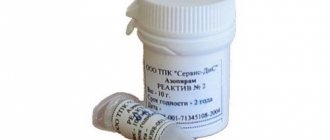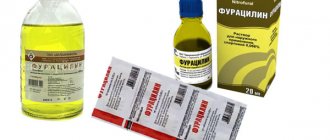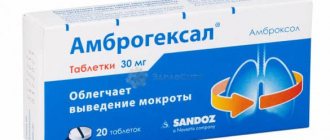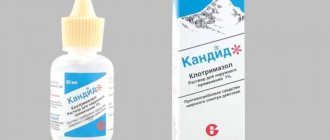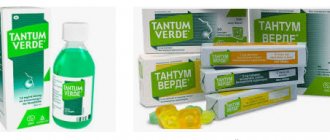Azopyram is a reagent that is used to identify hidden traces of blood remaining on medical devices prepared for sterilization as a result of insufficient pre-sterilization cleaning. All products in contact with the wound surface that have had contact with blood or injectable drugs, and certain types of medical instruments that during operation come into contact with the mucous membrane and can cause damage to it must undergo sterilization. The Azopyram kit allows you to find not only blood residues, but also traces of rust, as well as washing powder with bleaches. Using Azopyram, you can determine the remains of oxidizing agents, including chloramine and bleach, and peroxidase of plant origin. The Azopyram reagent also finds acids on medical products.
Release form and composition
The drug is produced by the manufacturer in two dosage forms: in the form of a powder concentrate (Azopyram SK) and in the form of ready-made alcohol solutions of reagents (Azopyram Kit).
The composition of the drug Azopyram SK includes a bottle with amidopyrine weighing 10 g and a bottle with aniline hydrochloric acid with a volume of 10 ml.
Azopyram The kit includes ready-made alcohol solutions of aniline (10 ml) and amidopyrine (90 ml).
One set is enough for an average of 2000 reactions (with a working solution consumption of 2 drops per reaction).
Purpose
Used to detect traces of blood, rust, acids, oxidizing agents (bleach, chloramine, chrome mixture, etc.), plant residues and washing powder with bleaches on medical products as part of quality control of their pre-sterilization cleaning in medical institutions, disinfection and sanitary and epidemiological stations.
Monitoring of pre-sterilization cleaning of medical instruments using Azopyram solution should be carried out in medical institutions at least once a week.
Instructions for use (method and dosage)
The contents of the bottle with aniline and stabilizer are dissolved in 60 ml of 95% ethyl alcohol, after which the volume of the solution is adjusted to 100 ml with ethyl alcohol. The resulting mixture is thoroughly mixed until completely dissolved. The Azopyram working solution, intended for direct testing of the quality of cleaning of medical equipment, is prepared as follows: equal parts of the drug and a 3% hydrogen peroxide solution are mixed.
When using Azopyram Kit, no additional alcohol is needed. Simply pour the aniline solution into a container with amidopyrine solution - and the drug will be ready for use.
Before using the working solution, be sure to test its suitability. To do this, apply 2-3 drops of the solution to the bloody stain. If a pink-violet color of the spot appears within a minute, the reagent is considered suitable for use. If there are traces of rust and chlorine-containing oxidizers on the surfaces and objects being examined, a brownish rather than lilac color is observed. If coloring does not appear during a test test or appears after 1 minute, the solution cannot be used.
The test products are wiped with swabs soaked in the working solution, or a few drops of the reagent are applied directly to the product with a pipette.
When checking reusable syringes, take 3-4 drops of solution into them and move the piston several times to moisten the inner surface of the product with the reagent, especially the places where the glass comes into contact with the metal. The solution is left in the syringe for one minute, after which it is squeezed onto a napkin.
When checking the quality of needle cleaning, the drug is drawn into a clean, corrosion-free syringe. Consistently changing the needles, the reagent is passed through each of them, squeezing 2-3 drops onto a gauze pad.
The quality of cleaning of catheters and other hollow products is assessed by injecting Azopyram solution into the products. The reagent is left for 1 minute, after which it is poured onto a gauze pad. The amount of drug introduced into the product depends on its size.
As a rule, 1% of simultaneously processed instruments of the same type are subject to control (at least 3-5 products). After the procedure, regardless of its results, the remaining solution should be removed from the products by wiping them with a swab or rinsing them abundantly with water, and then repeat the pre-sterilization cleaning.
What is azopyram
The azopyram test is carried out using a special reagent, which includes azopyram itself and 3% hydrogen peroxide, diluted in equal proportions. Azopyram is prepared from the above components: amidopyrine and aniline. Medical institutions purchase components for research in batches. Ethyl alcohol is sometimes used to create the reagent.
To properly dilute the substance, you must strictly follow the instructions. Azopyram is not the only component that is used in medicine for surface analysis by changing color or separating components. For example, the phenolphthalein solution, familiar to everyone from school lessons, is an indicator of an acidic or alkaline environment.
Preparation of the solution
Azopyram is available in different forms: Azopyram kit and dry powder concentrate (Azopyram SC). In the first case, you need to pour the contents of the vial with aniline into the amidopyrine solution to obtain the reagent. To prepare one liter of sample solution from dry powder, take one hundred gammas of amidopyrine and one and a half grams of aniline, which are diluted with ethyl alcohol to the required volume and mixed. The resulting initial reagent cannot be used in its pure form; it is diluted with hydrogen peroxide.
- How to put music on a video
- How to find a person by phone number
- A new service from Sberbank that helps pensioners find work
How to check the suitability of a solution
Before use, the working solution is tested for suitability at room temperature by applying it to a test sample. The test is not long, it is done within one minute. To do this, you need to take azopyram into a pipette and drop it onto the blood stain. If after one minute the solution has acquired a purple color, it means that the substance has been prepared correctly and is suitable for testing a medical instrument.
special instructions
The solution can only be used for processing medical instruments and items for professional use. The drug is not intended for use for medicinal purposes. All products undergoing the inspection procedure must be at room temperature.
Solutions of azopyram and aniline are flammable, since they contain ethyl alcohol, so they should not come into contact with hot surfaces of heating devices or open fire. The working solution must be used within two hours, after which it becomes unusable.
If reagents come into contact with the skin or mucous membranes, the affected area is thoroughly washed with running water.
Carrying out an azopyram test
Features of the event:
- The instrument must be dry and at room temperature. If moisture particles remain on the surface, wipe the devices thoroughly with a dry cloth;
- Place the tools in 1 layer on a clean napkin;
- Pipette a drop of the prepared azopyram solution onto all cutting parts, as well as into the joints and handles;
- Wait exactly 1 minute and evaluate the result.
How and with what to disinfect, sterilize and clean manicure instruments
Storage conditions and shelf life
Azopyram SK can be stored in its original packaging at a temperature of 18-25°C for two years.
Azopyram Kit is stored in a tightly closed bottle in a cool, dark place for no more than two months, and at room temperature for no more than a month. A slight yellowing of the solution without precipitation does not affect its working quality.
The reagents included in Azopyram SK and Azopyram Kit should be stored in tightly closed containers, separately from other medications, food, disinfectants, strong alkalis and acids.
Instructions for use:
Azopyram-Kit is a set of reagents for detecting hidden traces of blood on medical instruments prepared for sterilization.
Indications for use
The kit is used to control the thoroughness of pre-sterilization cleaning of all medical instruments that come into contact with the wound surface, come into contact with blood or injectable drugs (for example, a set of operating instruments).
Azopyram-Kit is used on medical products to detect traces of:
- blood;
- rust;
- washing powder with bleaches;
- acids;
- oxidizing agents (in particular, chrome mixture, bleach, chloramine, etc.);
- peroxidases of plant origin.
Inspections are carried out at disinfection and sanitary-epidemiological stations, as well as in all medical and preventive institutions.
Directions for use and dosage
To prepare the working composition, you need to transfer aniline hydrochloride (10 ml) into a bottle with amidopyrine solution (90 ml) and mix thoroughly. Immediately before the pre-sterilization test, the solution should be brought to a volume of 200 ml by adding 100 ml of 3% (pharmacy) hydrogen peroxide. The resulting mixture must be thoroughly mixed until completely dissolved and used within 2 hours.
Before starting work, you should conduct a suitability test, for which 2-3 drops of the working solution are applied to the blood stain. If a violet color appears within 1 minute, the reagent is considered suitable for use. If staining does not occur or it appears 1 minute after the test, the result is not taken into account and this solution cannot be used. Monitoring the cleaning of medical instruments before sterilization using Azopyram-Kit is carried out in medical institutions at least once a week . The control process is organized and carried out by the head nurse of the department. Once a quarter, control is carried out by sanitary and epidemiological stations.
The working solution (Azopyram-Kit reagents and 3% hydrogen peroxide in a 1:1 ratio) is applied to the medical instruments and products under study - wiped with a swab or applied directly to the instrument using a pipette. To check syringes (reusable), pour 3-4 drops of the working solution into them and move the piston several times to wet the entire inner surface of the instrument. To assess the quality of cleaning of catheters and other hollow products, a solution is injected into them using a syringe or pipette. The solution is left for 1 minute, after which it is poured onto a gauze napkin. The amount of reagent required to test a product directly depends on its size.
Using one Azopyram-Kit, you can carry out about 2000 reactions, based on the consumption of the working solution: 2 drops per 1 test.
How to check the suitability of a solution?
When storing the drug for a long time, there is a need to check its suitability before direct use. Before making an azopyram test on the surface, 2-3 drops of the solution are applied to the visible blood stain. If within 60 seconds it turns purple, which gradually turns blue, we can safely say that the reagent is completely suitable for use. If no purple coloration occurs within 1 minute, then this solution cannot be used, since it will not show the correct result.
special instructions
Moderate yellowing of the kit reagents (without precipitation) does not in any way reduce its quality.
When checking medical instruments, they must be at room temperature. Do not test hot products, and do not use the solution near heating devices.
The working solution (Azopyram-Kit reagents + 3% hydrogen peroxide) should not be kept in bright light and can only be used for 2 hours.
The drug is able to retain its properties after freezing and subsequent thawing.
Basic rules for conducting a test
The azopyram test, the algorithm for which is described above, may give a false result. To prevent this from happening, you must follow certain rules:
- Coloring that occurred later than 1 minute after treatment is not taken into account when analyzing the results.
- The temperature of the products being tested must be at room temperature. Samples of hot objects are not allowed.
- Do not keep the working solution (with hydrogen peroxide) in bright light or in a room with high temperature.
- The Azopyram working solution must be used within two hours, the preparatory solution can be stored at room temperature for 1 month, and when kept in a refrigerator - for 2 months. The container with the solution should be hermetically sealed, and the glass should be dark.
- After testing, the remaining solution must be removed, regardless of the result. To do this, objects must be washed with water or wiped with a swab, which has been previously moistened with water or alcohol. After this, it is necessary to repeat the pre-sterilization treatment.
The results of all tests performed are recorded in a special PSO quality log. If the examination shows the presence of contamination, the entire batch of instruments must be reprocessed.
Terms and conditions of storage
Store in original packaging at a temperature of 18-25°C, in a dark place out of reach of children.
Shelf life – 2 years.
The shelf life of the prepared solution in a tightly closed dark bottle at a temperature of 4°C is 2 months. In the dark, at room temperature, the shelf life of the prepared solution is no more than 1 month.
Instructions for using a set of reagents for quality control of pre-sterilization cleaning of medical devices (cat. no. b-50101)
PURPOSE
The kit is designed to detect blood residues, traces of rust, washing powder with bleaches, oxidizing agents (chloramine, bleach, chrome mixture, etc.), peroxidases of plant origin (plant residues) and acids on medical products when monitoring the quality of their pre-sterilization cleaning in medical - preventive institutions, sanitary-epidemiological and disinfection stations.
The kit is designed to prepare 200 ml of working reagent.
SET CONTENTS
Amidopyrine, 1ph…………………………………….10g
2. Aniline hydrochloride, stabilizer, 1f……………10ml
Additional reagents
3% (pharmacy) hydrogen peroxide, ethyl alcohol (not included in the kit).
ANALYTICAL CHARACTERISTICS
Sensitivity - a positive reaction is observed when blood is diluted by at least 100,000 times.
PRECAUTIONARY MEASURES
The reagents included in azopyram and its solutions should be stored in tightly closed containers, separate from food products, medications, disinfectants, strong acids and alkalis. Solutions of aniline and azopyram are flammable because They contain alcohol, so they should not be allowed to come into contact with open flames or hot surfaces of heating devices. If reagents come into contact with the skin or mucous membranes, wash them off under running water. When working with perhydrol, you should use rubber gloves.
PREPARATION OF REAGENTS FOR ANALYSIS
1. Preparation of an alcohol solution of azopyram
Dissolve the contents of the bottle with aniline hydrochloride and stabilizer in 60-70 ml of 95% ethyl alcohol, increase the volume with ethyl alcohol to 100 ml. Azopyram solution can be stored in a tightly closed bottle in a dark place at 2-8*C for no more than 2 months, at room temperature for no more than 1 month. Moderate yellowing of the solution during storage without precipitation does not impair its working quality.
2. Preparation of the working reagent Immediately before work, mix equal volumes of solutions of azopyram and 3% hydrogen peroxide. The working reagent can be used for 2 hours after preparation.
CONTROL
Treat the test products with the working reagent: wipe with swabs soaked in the reagent, or apply a few drops of the reagent to the test products using a pipette.
Take 3-4 drops of the reagent into the syringes and move the piston several times in order to moisten the inner surface of the syringe with the reagent, especially the junction of glass and metal, where blood most often remains. Leave the reagent in the syringe for 1 minute, then squeeze it onto a gauze pad.
When checking the quality of needle cleaning, draw the reagent into a clean, corrosion-free syringe and, successively changing the needles, pass the reagent through them, squeezing 2 drops onto a gauze pad.
The quality of cleaning boats or other hollow products can be assessed by introducing the reagent into the products or a pipette. Leave the reagent inside the product for 1 minute and then pour it onto a gauze pad. The amount of reagent introduced into the product depends on the size of the product.
1% of simultaneously processed products of the same name, but not less than 3-5 products, are subject to control.
In the presence of traces of blood or other contaminants, no later than 1 minute after contact of the reagent with the contaminated area, a violet color appears, turning into a pink-lilac or brownish color.
Coloring that occurs later than 1 minute after processing the test items is not taken into account.
After the test, regardless of its results, you should remove the remaining reagents from the test products by washing them abundantly with water or wiping them with a swab, and then repeat the pre-sterilization cleaning of these products.
NOTES
1. A brownish color is observed when there is rust or chlorine-containing oxidizers on the objects being examined; in other cases, the color is pink-lilac.
2. To protect azopyram from nonspecific oxidation by atmospheric oxygen, it contains a stabilizer, in the presence of which a slight yellowish color may appear in the azopyram working reagent, which does not interfere with the determination of contaminants.
3. Aniline hydrochloride with a stabilizer during long-term storage may acquire a yellow or brown tint, which does not impair the performance of the kit.
4. The suitability of the azopyram working reagent can be checked in the following way: apply 2-3 drops of the solution to the bloody spot. If, later than after 1 minute, a violet color appears, which then turns into a lilac color, the reagent is suitable for use; if color does not appear within 1 minute, the reagent cannot be used (most likely, the concentration of hydrogen peroxide is less than 3%)
Friends, we have made another useful video for you about the azopyram test. It is without sound, so it is equally important to watch the video and read the text below.
If you have any questions, be sure to ask in the comments.
What is an azopyram test?
This is a way to check the quality of pre-sterilization cleaning (PSC) of instruments. Simply put, we check whether traces of blood and biological fluids remain on the instruments even after PSO.
If the instrument is not cleaned properly, the azopyram working solution will turn purple. If PSO is carried out well, the solution will not change color.
Who needs to know this?
Cosmetologists, manicurists and pedicurists and, of course, workers in medical institutions. Anyone who, when working with tools, can damage the client’s skin.
How to conduct a test correctly?
Step 1.
Preparation of the working solution.
There are two options.
The first is the preparation of an azopyram sample from dry reagents.
To do this, you need to mix all the components of the reagent in the following proportions:
- amidopyrine – 100 g;
- analine hydrochloride – 1-1.5 g,
- Add ethyl alcohol 95% concentration to the required volume (about 1 l).
- Combine the resulting liquid with a 3% solution of hydrogen peroxide in equal proportions.
The finished liquid is called the working solution.
The solution is prepared immediately before testing and used within two hours after mixing the components. Otherwise, the sample efficiency will be zero.
If the reagent is stored in a room where the air temperature is above 25 degrees, it will turn pink faster.
The finished solution may turn yellow, this is acceptable if there is no sediment.
This solution preparation option is suitable for institutions that have a medical license and carry out medical activities.
According to SanPiN 2631-10, the use of alcohol is prohibited at public service enterprises, so you should use the second option.
The second option is to use a ready-made “Azopyram-Kit”.
This kit will greatly facilitate the preparation of an azopyram sample. The set contains only two bottles of reagents. The reagent from the small bottle must be poured into a large bottle. The result is a ready-made solution of azopyram.
Step 2. Adding hydrogen peroxide.
To perform an azopyram test, you will need 3% hydrogen peroxide.
Using a pipette, apply three drops of the prepared working solution of azopyram test and three drops of hydrogen peroxide onto a clean napkin.
Step
3. Testing.
We wipe the cutting elements of the instrument or those parts of it that come into contact with biological fluids or blood with a napkin. In the video, we took tweezers as an example.
If the tool has grooves or roughness (for example, cutters, and in our case it is a Uno spoon), the product is used in the form of drops. To do this, we will mix Azopyram with 3% hydrogen peroxide in equal parts and apply 2-3 drops to the instrument with a pipette. This is necessary so that the solution passes through all channels and joints of the tool parts.
After applying the product you need to wait 1 minute. During this time, the solution is allowed to drain onto a clean white napkin (this condition is one of the most important).
We will see the test results on a napkin in a minute. The result obtained after a longer time has no diagnostic value.
If the PSO was carried out poorly, and there are traces of blood or biological fluid on the instruments, after a minute a purple spot will appear on the napkin, and after a few seconds it will turn pinkish-blue.
If the stain on the napkin has a brown tint, it means there is rust or chlorine-containing oxidizers on the instruments. Pink color indicates the presence of detergents.
In our case, the reagent did not give positive results, so we believe that the instrument passed the PSA and there is no need to carry it out again.
To assess the quality of PSO, at least 1% of the instrument that has undergone a simultaneous cleaning procedure is taken. In the beauty industry, for a simpler count, at least three tools are taken from one batch.
How to check the suitability of a solution?
If the drug is stored for a long time, its suitability should be checked before use. Before making an azopyram test on the surface, 2-3 drops of the solution are applied to the blood stain. If within 60 seconds it turns purple, then the reagent is suitable for use. If coloring does not occur, then this solution cannot be used.
Several important rules for conducting an azopyram test:
- Coloring that occurs later than one minute after treatment is not taken into account when analyzing the results;
- The temperature of the instruments being examined must be at room temperature. Samples of hot objects are not allowed;
- Do not keep the working solution (with hydrogen peroxide) in bright light or in a room with high temperature;
- The Azopyram working solution must be used within two hours, the preparatory solution can be stored at room temperature for one month, in the refrigerator for two months.
- The container with the solution must be hermetically sealed and the glass must be dark.
- After testing, the remaining solution must be removed from the instrument, regardless of the result. To do this, items should be rinsed with water or wiped with a swab moistened with water or alcohol. After this, if necessary, repeat the pre-sterilization treatment or carry out sterilization.
- The results of all tests performed are recorded in a special PSO quality log. If the examination shows the presence of contamination, the entire batch of instruments must be reprocessed.
You can purchase Azopyram-Komplekt, as well as PSO quality control logs
Azopyram
- this is a chemical composition that includes a 10% solution of amidopyrine (the solution is made on the basis of ethyl alcohol) and aniline hydrochloride, the concentration of which is 0.10-0.15%.
In order to prepare this reagent, take 100 grams of amidopyrine and 1-1.5 grams of aniline hydrochloride. The resulting mixture is diluted with 96% ethyl alcohol until one liter of solution is obtained. The drug is sold as Azopyram-Kit, instructions
for which are included with the product.
basic information
The azopyram test is an assessment of the quality of disinfection and pre-sterilization treatment. It is carried out before the sterilization procedure for each batch of instruments processed during the day.
The azopyram test allows you to determine whether biological material remains on the instruments - blood, skin particles, biological secretions. The requirement to periodically assess the quality of pre-sterilization cleaning is regulated by SanPiN 2.1.3.2630-10 “Sanitary and epidemiological requirements for institutions engaged in medical activities.”
Disinfection and pre-sterilization cleaning of manicure instruments: how to choose a disinfectant and prepare the solution correctly
Paragraph 2.14 of the document describes how often you need to do an azopyram test and what to do with the results:
- How often should I do an azopyram test? Quality control is carried out daily;
- How many instruments are tested? 1% from each batch of processed instruments, but not less than 3 pcs. If you have to process 20 manicure tools, then you need to take 3 of them for testing;
- What to do with the results? The result is entered into the journal “Accounting for the quality of pre-sterilization treatment”. The correctness and systematic filling of the log is checked by Rospotrebnadzor during scheduled and unscheduled inspections. In this case, only negative results should be recorded in the journal. If positive, disinfection and PSO are repeated to eliminate contamination.
Stages of implementation:
- Preparation of the solution;
- Carrying out a test;
- Analysis of results and recording in the log book.
Safety precautions:
- the procedure should be carried out wearing gloves, goggles and a protective mask. Aniline, one of the components of azomiram liquid, is a toxic substance and can lead to poisoning;
- the room where the azopyram test is carried out is ventilated after the procedure so that toxic substances do not linger in the air.
Purpose of the drug
Any medical instruments that come into contact with human blood must undergo pre-treatment. Such instruments include all surgical devices, catheters, injection syringes and others. They are processed in two stages: pre-sterilization treatment and sterilization itself. Before sending instruments for sterilization, they must undergo pre-sterilization treatment, which includes soaking in disinfectant and cleaning solutions. After all, during any manipulation, blood, microscopic pieces of skin, etc. remain on medical instruments.
Even if we take into account that theoretically any microorganisms will die during sterilization, the presence of blood and epithelial cells dried on the instruments can still have a bad effect on both the person undergoing procedures using these devices and themselves. That is why treatment with special solutions is carried out. However, then these solutions must be thoroughly washed, and only then the instruments must be sterilized.
Azopyram was developed to check the quality of pre-sterilization treatment
.
A medical professional cannot see traces of blood remaining on a syringe or any other device after it has been washed in solutions. However, small particles of blood sometimes remain after not very thorough treatment. To detect these particles, an azopyram test
, with the help of which it is determined how well or poorly the instruments were processed.
Blood is not the only substance to which this reagent reacts. Thanks to it, you can also detect residues of detergent on instruments that were poorly washed after treatment, acid or rust.
Properties and method of use of the solution
Azopyram
It is not used in its pure form, but diluted with 3% hydrogen peroxide in a 1:1 ratio. However, you should know that a ready-made solution diluted with peroxide can be used no later than during the first two hours after its preparation. At this time, he should under no circumstances be in bright light. Also, do not test near any heating devices or test hot tools.
How is an azopyram test
? To do this, simply take the prepared mixture of the reagent and hydrogen peroxide and apply it to the instrument being tested. You can apply it using a pipette or a cotton swab soaked in the solution. It all depends on what exactly needs to be checked. For example, to treat syringes, it will not be enough to simply lubricate them with a swab with a reagent. You also need to pour a little solution inside each syringe and distribute it evenly along the walls using the movements of the piston.
In order to determine the quality of pre-sterilization treatment of medical instruments, you will have to wait no more than one minute. During this time azopyram
or will react to the presence of blood (detergents, rust) or no reaction will follow due to the absence of the listed substances on the instruments.
The reaction manifests itself as the appearance of a purple color in the solution at the site where undesirable elements are found. In this case, we can say that the azopyram test
is positive.
It is important to know that the reaction must occur within the first minute after applying the solution to the surface of the instruments. If it appeared after a longer period, you can ignore such a reaction, it does not correspond to reality, and the devices are processed well.
Also, a person involved in pre-sterilization treatment needs to know that before conducting tests, azopyram
must be checked for suitability. After all, if the expiration date expires, the reagent loses its properties and may not react to existing contaminants. Even the reagent undiluted with hydrogen peroxide can be stored for only 2 months, and even then in the refrigerator, in a darkened bottle. If you store it at room temperature, then even in a dark place it will lose its quality in about a month. Therefore, reagent testing is very important to perform correct samples.
You should check a ready-made solution diluted with hydrogen peroxide. Such a test involves applying a reagent to any blood spot that a person can see without magnifying instruments. Next, the reaction of the drug is monitored. If the reaction appears within a minute, then it is usable and can be used to check all other instruments.
This reagent is a necessary condition for working with medical devices. Without its use, you cannot be sure of the quality of their processing.
Preparation of the solution
There are two ways to prepare the liquid for the procedure:
- from amidopyrine in the form of a dry powder. For 1 liter of the finished reagent, mix 100 g of amidopyrine in a clean, dry container with 1-1.5 g of aniline hydrochloride. Bring the mixture to 1 liter by adding 95% ethyl alcohol;
- from an azopyram kit, including 2 mixing reagents. To prepare, simply mix the contents of two bottles thoroughly. There is such a kit.
The resulting solution is ready, but not working. To prepare the working fluid, it is necessary to add hydrogen peroxide to azopyram.
- Measure out an equal amount of prepared azopyram solution and 3% hydrogen peroxide;
- Mix azopyram and peroxide and you will get a working reagent.
The working solution must be used no later than 60-120 minutes after preparation. After this time, it is unsuitable for work.
For the exact service life of the working fluid, see the instructions for the specific product.
The stores offer different kits and reagents for preparing the solution, including those with letter additives:
- Azopyram-D;
- Azopyram-R;
- Azopyram-SK;
- Azopyram-P;
- Azopyram-K.
Depending on the product you choose, the technology for preparing the finished solution will change slightly, so be sure to study the instructions for the drug. In this case, the evaluation of the solution and the test result do not depend on the manufacturer and kit configuration.
